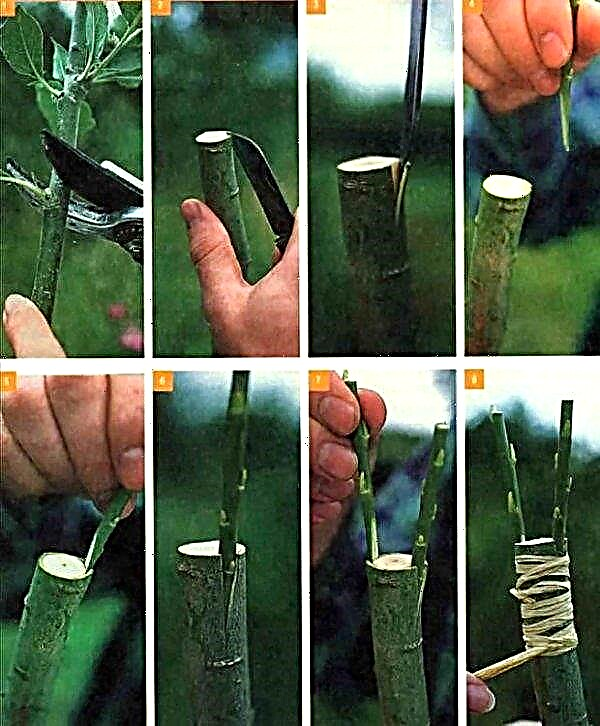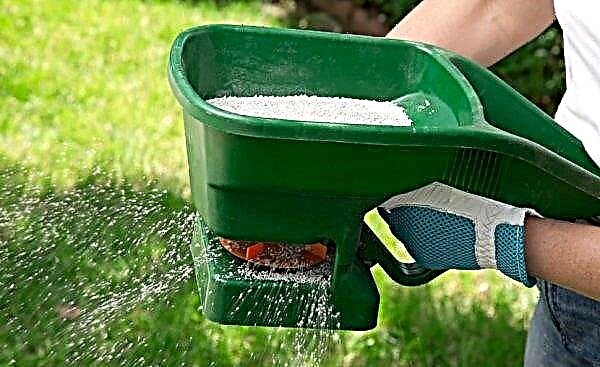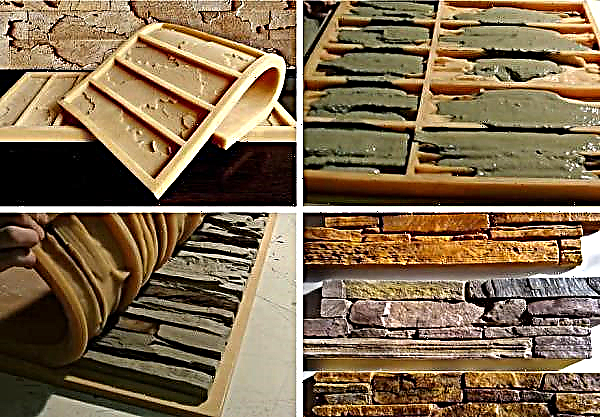Most summer residents seek not only to build a solid and beautiful house, but also to refine the area around it. An integral part of landscape design, in most cases, becomes a flower garden. It is he who pleases not only with a variety of colors, but also gives special sensations in the form of pleasant aromas. To realize a truly original and unusual idea, you can use the cart or part of it. Such products perfectly complement the rustic style or country-style.
Varieties and sizes of carts
Landscaping is infinitely diverse. The use of one or another element depends solely on a person’s imagination. Therefore, it is difficult to count variations in the use of such an unusual element when decorating a personal garden or summer cottage. However, a common feature that is characteristic when using carts is there. Near this design, on or under it, flowers or other decorative products must necessarily grow.
Did you know? Although the concept of "Landscape Design" is only 200 years old, compositions for decorating gardens and plots have been used since the reign of the Egyptian pharaohs.
Accordingly, carts for decorating the garden can have not only a different appearance from each other, but also sizes.
- Small-sized. Usually its length does not exceed 1 m. It is precisely this minimalism that allows you to combine this product with small flower beds or lawns. Therefore, more and more such structures can be found on the territory of standard residential buildings in the private sector.

- Medium format. Its length rarely exceeds 2.5 m, but it will not be shorter than the mark of 2 m. Such designs can have two, three or four wheels. It is usually chosen as a decor element near a building or fence.

- Oversized. In this category there are products whose length exceeds an indicator of 3 m. Naturally, this design can have only 4 wheels, so as not to fall apart under gusts of wind. Since the option is too cumbersome, it is not recommended to place it in a small space.

Quite often, as a stylistic "highlight" you can meet the wheel itself, without a cart. It is also ideal for decorating a village or country.
How to do it yourself
Although it might seem at first glance that the technology of creating a cart is complicated, in practice, such work will not take up much time or effort.
But it is necessary to clearly follow several main rules, namely:
- The choice of the type of future design and its parameters.
- Drawing up the drawing on the estimated sizes. At the same time, attention is paid to even the smallest details.
- Production of elements and assembly.
- Installation on the site and decoration.

It should be understood that the minimum skills when working with a tree will still be required. And if there are none, then the best way out of the situation is to turn to professionals.
Drawing preparation
No serious project can be implemented without first sketching the paper. This means that each cart designed by the designer will have a kind of "passport", i.e. drawing.

The accuracy of subsequent work depends on the detail of its execution. After all, even a slight error in the parameters can lead to disappointment with the result of the work done.
In addition to the cart itself, you will have to create separate drawings for its elements - wheels, bodywork, axles, etc. This should not be a normal drawing, but a real diagram that the carpenter can read. In other words, the exact dimensions of each part must be indicated on it.
Making a cartwheel
The most problematic and difficult in terms of design will be the manufacture of wheels. The easiest way is to cut a log of suitable diameter. From the obtained round billet of the desired thickness, you can create the necessary element yourself.
In the center of this part, a hole is drilled and put on the axis. The second method is the creation of two identical in diameter billets and their subsequent connection.

Nevertheless, in landscape design it is customary to pay attention to every detail. Therefore, the most beautiful and aesthetically pleasing wheel will look. It is not easy to make such a part. Only a true master can cope with work.
Important! It is easier to trim the knitting needles than to drill a groove for their size on the inside of the rim or on the hub.
Beginners are advised to seek the help of carpenters.
- Initially, you need to prepare a template. Create it in accordance with the real value of the future product. Plywood is often used as material.
- On the workpiece determine the center. You can do this with a ruler and a pencil. The circle is divided into four sectors. Where the lines cross each other, there will be a center. A nail should be driven into it.
- Then prepare a plank of wood. Its length should correspond to the radius of the circumference of the future wheel. Two holes are drilled in it. One should coincide with a previously driven nail. Another will be needed for a pencil.
- With the help of a strap and a stylus placed inside, an even circle is drawn. In a similar way, but with a smaller board size, create an inner circle. These two circles will be the rim. It is worth remembering that all sizes must correspond to the parameters indicated in the drawing.
- The resulting circle is again divided into 8 equal sectors. Accordingly, the rim should also have the same marks. Based on the size, small bars are cut from the tree. Their length and width will depend on the specified parameters when measuring. The ends are neatly aligned so that they look like an octagon. Be sure to make sure that the junction ideally matches the groove inside the rim.
- Although this method involves the creation of a polygonal product, rounded shapes look most attractive. Therefore, all surface irregularities are treated with sandpaper to remove sharp corners. In this case, the finished design will resemble the real wheel as much as possible.
Often the wheels are used as a separate decoration in the creation of small flower beds. Along the rim, you can let out climbing plants that perfectly fit into the surrounding space.
How to plant wheels on the axle
In the central part of the wheel, it is necessary to place a wooden chock, which will become the hub. It can be made from a special blank, for example, a shovel from a shovel, using a jigsaw.
As spokes use trims that were previously made according to the above scheme. In some cases, they can be made from other, more elaborate, blanks using professional machines. But such work will take more time and require the ability to handle turning equipment.

Further, holes for knitting needles are drilled in the hub. These grooves should be on the inside of the workpiece. In total, 16 holes are created: 8 are placed on the rim itself, the rest on the hub. Their diameter should be the same as that of prepared rods. Using glue or screws, the knitting needles are connected to the rim and hub. It turns out a real wheel.
For some time, when using glue, the product must be kept “under pressure”. This is necessary so that the structural elements are snug against each other. As extra weight, any heavy parts can be used. If they are metal, then in order to avoid damage to the surface of the tree, the wheel is wrapped with a layer of rags.

Bodywork
One of the elements that must be indicated in the drawing is the body. This is the main part of the cart, in which flowers or decorative elements will be placed.
Initially, the bars are prepared from which the frame will be assembled, and the boards playing the role of partitions on the case. All parts must be manufactured and interconnected in accordance with the drawing. The bottom is made of boards. They are fastened together by bars. The total size of the future cart will depend on the cross-section of lumber.Important! Coating the elements of the cart with varnish will provide not only the attractiveness of the design, but also durability.

The body base must be fixed with several fasteners at once. It will be glue, and screws, and, most likely, nails. Almost finished frame is covered with boards of the desired length. The final stage of construction will be grinding the product, applying a protective layer of varnish.
Step-by-step instructions for installing a body on a finished axle
In order to make the connection between the body and the wheelbase, you will need to follow clear rules.
Its main rules in this case will be:
- The cart body is turned upside down.
- It measures the distance from the edges and marks the future location of small wooden bars. Their length should be 5-10 cm less than the frame itself. In the marked place they are fastened with screws and body glue.
- Previously prepared axles with fixed wheels are placed on these bars.
- With the help of glue and fasteners connect these parts together.
- It remains only to turn the cart and put it on wheels.
 The finished trolley can be installed in a selected place in the garden, and then decorated according to stylistic preferences.
The finished trolley can be installed in a selected place in the garden, and then decorated according to stylistic preferences.
Dressing carts for the garden
In most cases, a similar design is created or acquired as the basis for a flower garden. In such a cart there will be enough free space to place a layer of fertile soil in its hull and plant several types of flowers. A great option would be the choice of varieties and species that curl upward.
Did you know? You can use in landscape design not only natural materials and plants, but also shade. If it falls beautifully on a trolley, then such a lighting effect will give the composition a special charm.
The design is universal. It can be used throughout the year without the need for shelter or canopy. You can also take out and install potted plants inside the body in the summer, and in winter it will play the role of a place to store firewood.
 If you tilt the cart a little forward, then you can create an artificial cascade of flowers in it. For this idea, you will need to plant some of the plants in the back, and the rest on the ground. It is not necessary to deposit soil directly into the cart itself. In it you can place a plastic or wooden container. Plants will grow in it.
If you tilt the cart a little forward, then you can create an artificial cascade of flowers in it. For this idea, you will need to plant some of the plants in the back, and the rest on the ground. It is not necessary to deposit soil directly into the cart itself. In it you can place a plastic or wooden container. Plants will grow in it.
Not only flowers can be placed inside. They allow the installation of decorative garden figures, lining the bottom with straw, decoration with dummies of fruits and vegetables. In some cases, a tow bar is mounted at the rear of the cart. You can hang a bucket on it. A small product can be made independently from a flower pot.
On the sides of the cart you can decorate, for example, horseshoes. You can create them yourself. To do this, cut out a template from paper. It is laid on a plywood sheet and, using a jigsaw, the workpiece is cut out. In addition to applying a metallic shade of paint, it is necessary to make holes. They not only fulfill the role of fastening, but also give the most realistic look to crafts.
If on the site most of the buildings are made of wood, and the landlord prefers this natural material in landscape design, then the cart can be loaded with firewood. She will harmoniously fit into the surrounding style.
The decorative cart is used in different ways. It can accommodate a flower, a garden figurine, even ordinary firewood. The main thing is to approach its design with soul and imagination. Other decorative wooden elements, for example, a well, a mill or plates, can complement the design. As mentioned above, only wheels can be used.
Where better to install on the site
This decorative design element is created in order to please the eyes of the owner and guests of the site. Therefore, the cart is usually installed in a conspicuous place - in front of the house or on the lawn. With its help, for example, you can hide any unaesthetic part of the site. This may be a crumbling section of the fence, a pile of construction waste that has nowhere to put or uneven ground cover.
Since the product is most often used as a flower bed, it is necessary to place it in similar places. This may be the space in front of the windows. Such a cart looks beautiful near greenhouses or a garden. In the shaded sector of the garden, it is located near a resting place or benches.
With your own hands to create a decorative cart is easy. It is only necessary to follow the described rules or seek the help of a professional. A place for this unusual and beautiful element of landscape design can always be found even in a small territory of a summer cottage. Such a flower garden will become not only a matter of pride for the residents of the estate, but will also make friends more often visit.















